Aquacultural production is a major industry in many countries, and it will continue to grow as the demand for fisheries products increases and the supply from natural sources decreases.
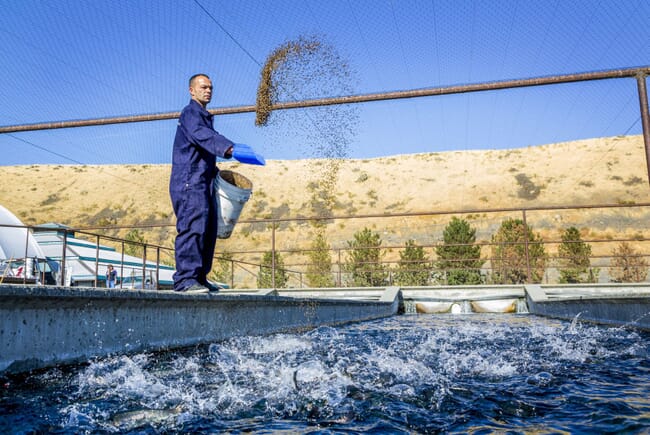
As in more traditional forms of animal production, nutrition plays a critical role in intensive aquaculture because it influences not only production costs but also fish growth, health and waste production (Gatlin, 2002).
To develop nutritious, cost-effective diets we must know a species' nutritional requirements and meet those requirements with balanced diet formulations and appropriate feeding practices.
Research over the last two decades has expanded our knowledge of the nutritional requirements of cultured fishes. This publication provides an overview of the general principles of fish nutrition as they relate to aquaculture.
Major nutrient groups
Energy-yielding nutrients
Proteins, carbohydrates and lipids are distinct nutrient groups that the body metabolises to produce the energy it needs for numerous physiological processes and physical activities.
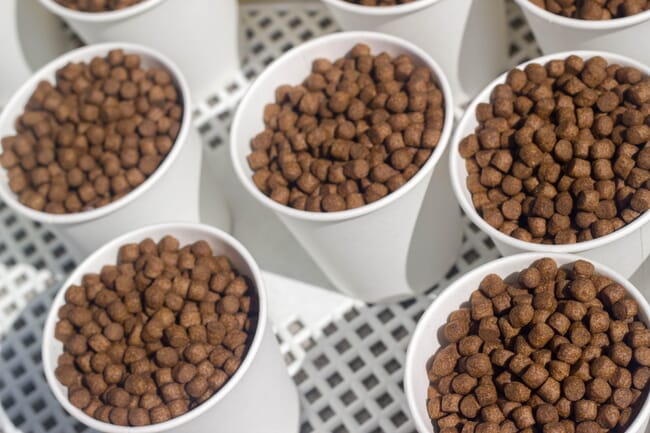
There is considerable variation in the ability of fish species to use the energy-yielding nutrients. This variation is associated with their natural feeding habits, which are classified as herbivorous, omnivorous or carnivorous.
Thus, there is a relationship between natural feeding habits and dietary protein requirements. Herbivorous and omnivorous species require less dietary protein than some carnivorous species (NRC, 1993).
Carnivorous species are very efficient at using dietary protein and lipid for energy but less efficient at using dietary carbohydrates. The efficient use of protein for energy is largely attributed to the way in which ammonia from de-aminated protein is excreted via the gills with limited energy expenditure. The foods carnivorous species eat contain little carbohydrate, so they use this nutrient less efficiently.
In terms of energy density, proteins, carbohydrates and lipids have average caloric values of 5.65, 4.15 and 9.45 kilocalories per gram (kcal/g), respectively. These gross energy values are obtained by fully oxidising the nutrients and measuring their heat of combustion in a calorimeter, with the energy released expressed as kcal/g or kiloJoule (kJ)/g (1 kcal = 4.185 kJ).
Not all of the gross energy from nutrients is utilised because some of it is not digested and absorbed for further metabolism. Thus, the amount of digestible energy (DE) provided by a feed or feed ingredient is commonly expressed as a percentage of gross energy. A smaller fraction of the DE absorbed by the fish will be lost in metabolic wastes, including urinary and gill excretions, but these losses are relatively minor compared to the dietary energy excreted in the faeces.
Because it is hard to collect fish urinary and gill excretions, it is much more difficult to determine metabolisable energy (ME) values for aquatic organisms than for terrestrial animals. Therefore, ME values are not commonly reported for fish feeds or ingredients.
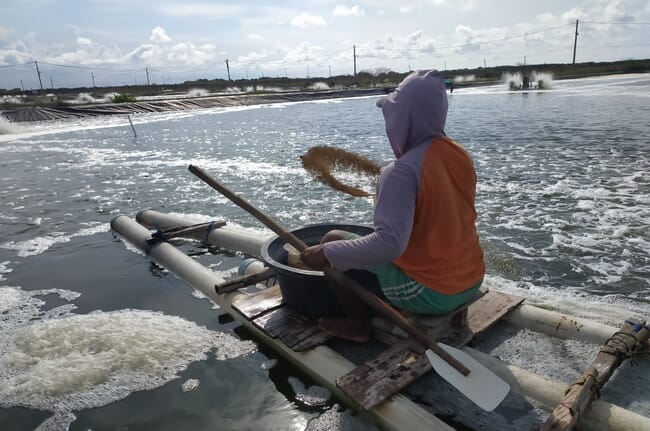
© Minapoli
Proteins and amino acids
Proteins consist of various amino acids, the composition of which gives individual proteins their unique characteristics. Many of the biochemicals required for normal bodily functions are proteins, such as enzymes, hormones and immunoglobulins. Fish, like other animals, synthesise body proteins from amino acids in the diet and from some other sources.
Amino acids that must be provided in the diet are called “essential” or “indispensable” amino acids. Quantitative dietary requirements for the ten indispensable amino acids have been determined for several fish species (Wilson, 2002).
There are also ten “nonessential” or “dispensable” amino acids that the body can synthesise from other sources. These dispensable amino acids also may be found in dietary protein and used for synthesising body proteins. Table 1 lists indispensable and dispensable amino acids.
A deficiency of any one of the indispensable amino acids can limit protein synthesis, which often causes reduced weight gain and other specific symptoms.
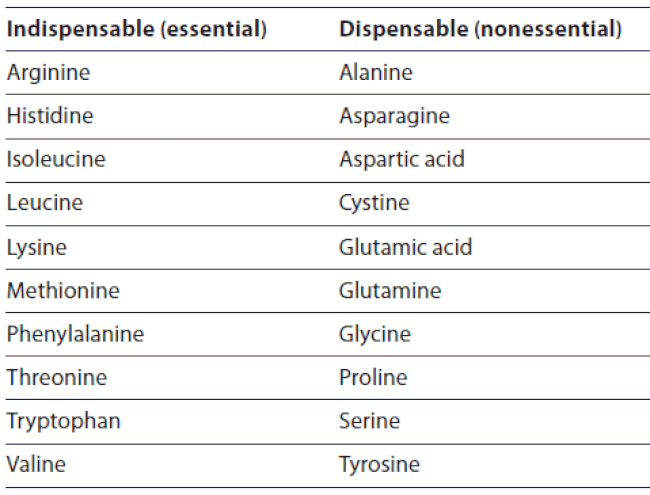
Meeting a fish’s minimum dietary requirement for protein, or a balanced mixture of amino acids, is critical for adequate growth and health.
However, providing excessive levels of dietary protein is both economically and environmentally unsound because protein is the most expensive dietary component and excess protein increases the excretion of nitrogenous waste.
Most herbivorous and omnivorous fish evaluated to date require a diet with 25 to 35 percent crude protein; carnivorous species may require 40 to 50 percent crude protein (Wilson, 2002). Commercial feeds are carefully formulated to ensure that protein and amino acid requirements are met.
Carbohydrates
Fish do not have a specific dietary requirement for carbohydrates, but including these compounds in diets is an inexpensive source of energy. The ability of fish to utilise dietary carbohydrate for energy varies considerably; many carnivorous species use it less efficiently than do herbivorous and omnivorous species (Wilson, 1994). Some carbohydrate is deposited in the form of glycogen in tissues such as liver and muscle, where it is a ready source of energy. Some dietary carbohydrate is converted to lipid and deposited in the body for energy.
Carbohydrates of various size (carbon chain length) and complexity (one to several units bonded together) are synthesised by plants via photosynthesis. Cellulose and other fibrous carbohydrates are found in the structural components of plants and are indigestible to monogastric (simple-stomach) animals, including fish. In fact, the amount of crude fibre in fish feeds is usually less than 7 percent of the diet to limit the amount of undigested material entering the culture system.
Soluble carbohydrates such as starch are primary energy reserves found in seeds, tubers and other plant structures. Animal tissues such as liver and muscle contain small concentrations of soluble carbohydrate in the form of glycogen, which is structurally similar to starch.
This glycogen reserve can be rapidly mobilised when the body needs glucose. Prepared feeds for carnivorous fish usually contain less than 20 percent soluble carbohydrate, while feeds for omnivorous species usually contain 25 to 45 percent. In addition to being a source of energy, soluble carbohydrate in fish feed also gives pellets integrity and stability and makes them less dense.
Lipids
This nutrient group consists of several different compounds. Neutral lipids (fats and oils), in the form of triglycerides, provide a concentrated source of energy for aquatic species. Dietary lipid also supplies essential fatty acids that cannot be synthesised by the organism (Sargent et al, 1995).
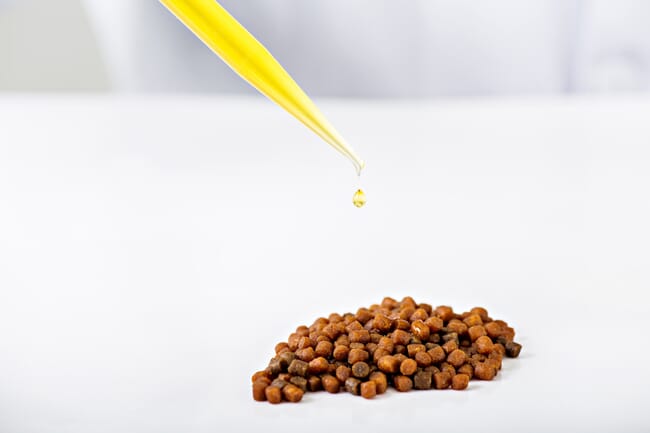
© Nofima
Fatty acids of the linoleic acid (n-3) family are generally more essential to fish than those of the linoleic acid (n-6) family. The n- or “omega” nomenclature is used to describe fatty acids by the general formula X:Yn-z, where X is the carbon chain length, Y is the number of ethylenic/double bonds, and n-z (or -z) denotes the position of the first double bond relative to the methyl end of the fatty acid.
Thus, 16:0 denotes a saturated fatty acid containing 16 carbons and no double bonds (all carbons saturated with hydrogen), and 18:1n-9 (18:1/9) designates a monounsaturated fatty acid with 18 carbon atoms and a single double bond that is nine carbon atoms from the methyl end.
Many freshwater fish can elongate and de-saturate 18-carbon linolenic acid with one double bond to longer chains (20 and 22 carbons) of more highly unsaturated fatty acids (HUFAs) with five or six double bonds. In contrast, most marine fish must have HUFA in the diet.
In the body, HUFAs are components of cell membranes (in the form of phosphoglycerides, or phospholipids), especially in neural tissues of the brain and eye. They also serve as precursors of steroid hormones and the highly active eicosanoids produced from 20-carbon HUFAs (Sargent et al, 1995).
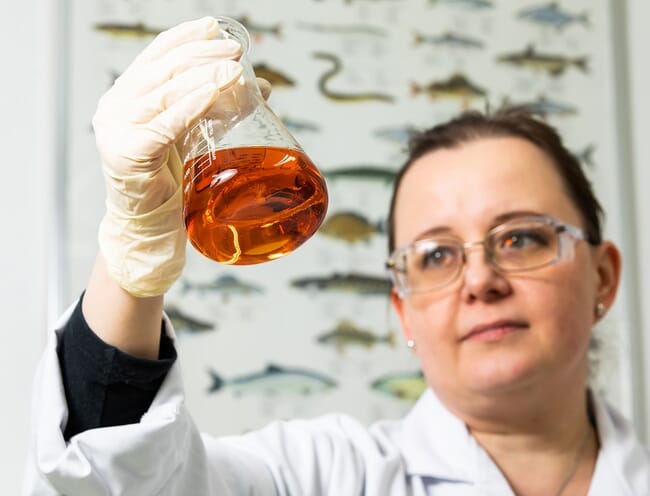
© Karen Murray
Eicosanoid compounds include cyclic molecules such as prostaglandins, prostacyclins and thromboxanes produced by the action of cyclo-oxygenase, as well as linear compounds such as leukotrienes and lipoxins initially formed by lipoxygenase enzymes.
Eicosanoids are responsible for blood clotting, immunological and inflammatory responses, renal function, cardiovascular tone, neural function, and other functions. A diet deficient in essential fatty acids reduces weight gain, but usually after an extended period. This is due to mobilisation of essential fatty acids from endogenous tissue lipids.
Micronutrients
Minerals
This nutrient group consists of inorganic elements the body requires for various purposes. Fish require the same minerals as terrestrial animals for tissue formation, osmoregulation and other metabolic functions (Lall, 2002). However, dissolved minerals in the water may satisfy some of the metabolic requirements of fish.
Minerals are typically classified as either macro- or microminerals, based on the quantities required in the diet and stored in the body.
Macrominerals are calcium, phosphorus, magnesium, chloride, sodium, potassium and sulfur. Dietary deficiencies of most macrominerals have been difficult to produce in fish because of the uptake of waterborne ions by the gills. However, it is known that phosphorus is the most critical macromineral in fish diets because there is little phosphorus in water.
Because excreted phosphorus influences the eutrophication of water, much research has been focused on phosphorus nutrition with the aim of minimising phosphorus excretion. Phosphorus is a major constituent of hard tissues such as bone and scales and is also present in various biochemicals. Impaired growth and feed efficiency, as well as reduced tissue mineralisation and impaired skeletal formation in juvenile fish, are common symptoms when fish have diets deficient in phosphorus (Lall, 2002).
Chloride, sodium and potassium are important electrolytes involved in osmoregulation and the acid–base balance in the body (Lall, 2002). These minerals are usually abundant in water and practical feedstuffs.
Magnesium is involved in intra- and extracellular homeostasis and in cellular respiration. It also is abundant in most feedstuffs.
The microminerals (also known as trace minerals) include cobalt, chromium, copper, iodine, iron, manganese, selenium and zinc. Impaired growth and poor feed efficiency are not readily induced with micromineral deficiencies, but may occur after an extended period of feeding deficient diets (Lall, 2002). The trace minerals and their metabolic functions in fish are shown in Table 2. The quantitative dietary requirements for some fish species have been established (Lall, 2002).
Copper, iron, manganese, selenium and zinc are the most important to supplement in diets because practical feedstuffs contain low levels of these microminerals and because interactions with other dietary components may reduce their bioavailability. Although it is not usually necessary to supplement practical diets with other microminerals, an inexpensive trace mineral premix can be added to nutritionally complete diets to ensure an adequate trace mineral content.
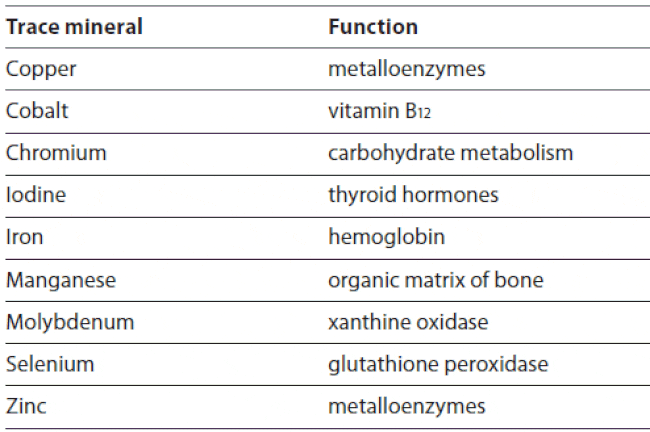
Vitamins
Fifteen vitamins are essential for terrestrial animals and for several fish species that have been examined to date (Halver, 2002) (Table 3). Vitamins are organic compounds required in relatively small concentrations to support specific structural or metabolic functions. Vitamins are divided into two groups based on solubility.
Fat-soluble vitamins include vitamin A (retinol), vitamin D (cholecalciferol), vitamin E (alpha-tocopherol) and vitamin K. These fat-soluble vitamins are metabolised and deposited in association with body lipids, so fish can go for long periods without having these vitamins in the diet before they show signs of deficiency.
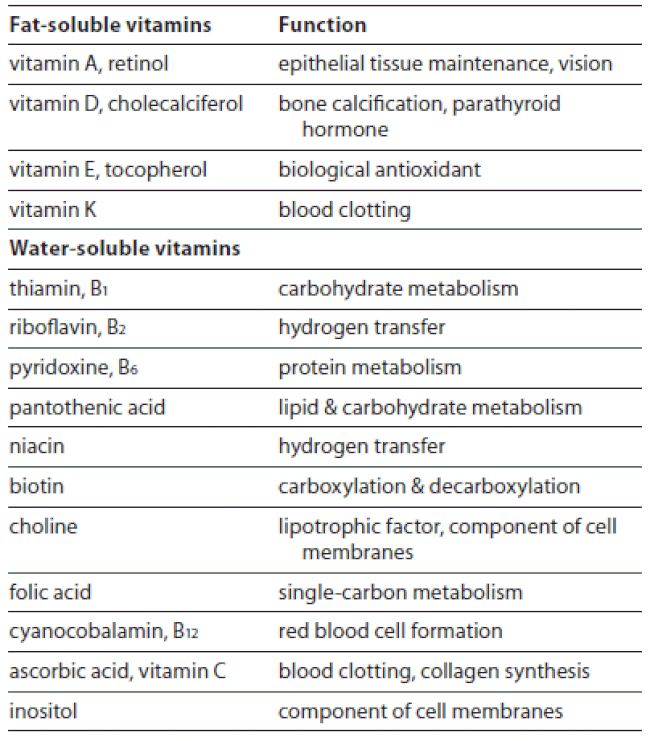
Water-soluble vitamins include ascorbic acid (vitamin C), biotin, choline, folic acid, inositol, niacin, pantothenic acid, pyridoxine, riboflavin, thiamin and vitamin B12. They are not stored in appreciable amounts in the body, so signs of deficiency usually appear within weeks in young, rapidly growing fish.
Most of these water-soluble vitamins are components of coenzymes that have specific metabolic functions. Detailed information about the functions of these vitamins and the amounts fish need have been established for many cultured fish species (Halver, 2002).
Vitamin premixes are now available to add to prepared diets so that fish receive adequate levels of each vitamin independent of levels in dietary ingredients. This gives producers a margin of safety for losses associated with processing and storage.
The stability of vitamins during feed manufacture and storage has been improved over the years with protective coatings and/or chemical modifications. This is particularly evident in the development of various stabilised forms of the very labile ascorbic acid (Halver, 2002). Therefore, vitamin deficiencies are rarely observed in commercial production.
Digestion and metabolism
The nutrients fish ingest in prepared feeds are broken down by digestive fluids and enzymes and then absorbed from the gastrointestinal (GI) tract into the blood. The digestion process in fish is similar to that in other monogastric animals; it involves physical, chemical and physiological processes within the GI tract.
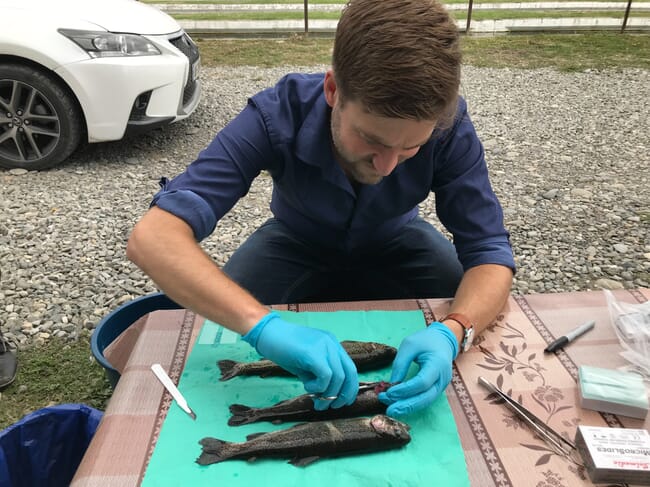
There is a wide range in the sizes and shapes of GI tracts in fish, but they all generally consist of the same basic structures —the esophagus, acid-producing stomach and intestine (though some fish, such as cyprinids, do not have an acidic stomach). The GI tract also includes pyloric ceca, which are protrusions posterior to the stomach that increase the absorptive area of the GI tract.
Accessory organs that interface with the GI tract include the pancreas, which produces a variety of digestive enzymes, and the liver and gall bladder, which produce and store bile salts for emulsification of lipids in the GI tract.
Protein digestion begins in the stomach, a low-pH environment resulting from hydrochloric acid secretion and the proteolytic enzyme pepsin. Upon exiting the stomach, the ingesta (chyme) is neutralised by fluids in the intestine and further acted upon by enzymes from the pancreas and intestine. These enzymes aid in the breakdown of complex proteins, carbohydrates and lipids into small molecules that are eventually absorbed into the blood.
Intermediary metabolism
The liver plays a major role in directing the various nutrients to specific organs and tissues to be metabolised for energy. The same basic metabolic pathways for converting amino acids, carbohydrates and lipid into energy have been observed in fish as in terrestrial animals.
It is preferable for dietary carbohydrates or lipid to be metabolised for energy so that protein (amino acids) can be used for tissue synthesis. To ensure this, there must be a proper balance of dietary protein to energy to optimise fish growth and lean tissue accretion. Energy-to-protein ratios ranging from 8 to 10 kcal of DE/g of protein (33 to 42 kJ/g) are optimal for various fish species.
Nutrient and energy utilisation
The fractions of dietary nutrients or energy that are eliminated in the faeces represent undigested components that do not contribute to the nutrition of the fish. So it is generally desirable to use feeds that have a high level of digestibility.
Coefficients of nutrient and energy digestibility for complete feeds or specific ingredients can be used to assess the relative percentage of ingested nutrients that are retained by the fish.
Digestibility coefficients for specific feedstuffs can help producers more precisely formulate feeds to meet the nutrient requirements of the cultured species. This information is now available for many common feedstuffs and established fish species.
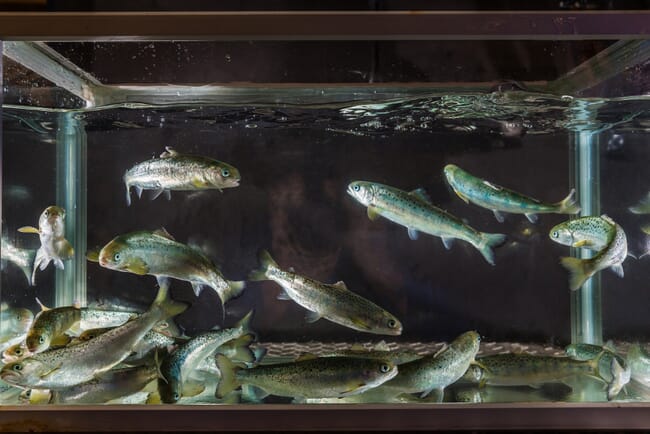
Feed ingredients, formulation and manufacture
Feed Ingredients
Byproducts from the processing of plant and animal products for human foods are the primary ingredients available for fish feeds. Most of these ingredients have limited levels of nutrients, or even anti-nutritional factors, and are included in diet formulations only within specific limits. However, complementary ingredients can be combined to meet the nutritional requirements of fish.
The major ingredients in prepared fish feeds are protein supplements and energy supplements. Protein supplements contain more than 20 percent crude protein, while energy concentrates have less than 20 percent crude protein and less than 18 percent crude fibre.
Plant feedstuffs in the protein supplement category include oilseed meals such as soybean meal, cottonseed meal and canola meal, as well as other protein concentrates from cereal grains, including corn gluten, distillers dried grains with soluble, and wheat gluten.
Animal feedstuffs in the protein category include cattle and swine byproducts such as blood meal, meat meal, and meat and bone meal; poultry byproduct meal and feather meal; and fishmeal from various reduction fisheries or processing byproducts.
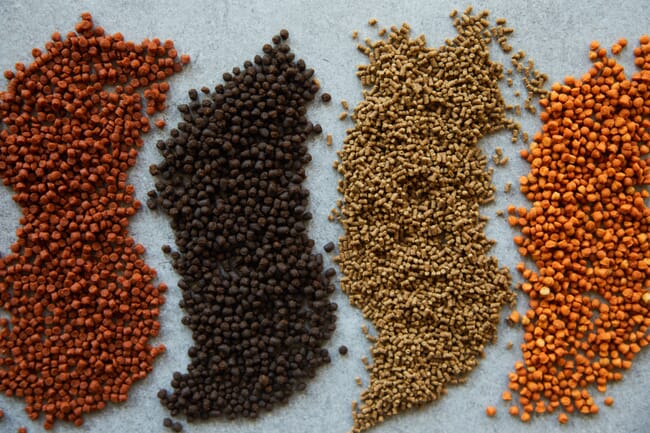
© CAT
Energy concentrates include feed-grade cereal grains such as corn, wheat, sorghum and milling byproducts such as wheat middlings and rice bran. Fats and oils are the other source of concentrated energy for fish diets. These include feed-grade plant products such as soybean, safflower and canola oils, and animal fats such as beef tallow, poultry fat and fish oil. Blends of animal and vegetable oils also may be used in fish diets.
Two other classes of feedstuffs are the mineral supplements and vitamin supplements, which are commonly purchased as premixes and added to nutritionally complete feeds to ensure that all nutrient requirements are met.
A final class of feedstuffs is additives. These are compounds such as antioxidants, binding agents, enzymes, immunostimulants, palatability enhancers, prebiotics and probiotics that may be added to fish feeds at relatively low concentrations to confer specific benefits (Gatlin and Li, 2008).
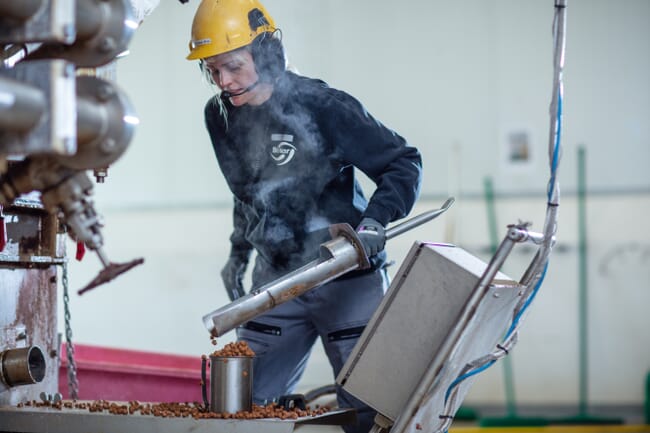
© Biomar
The major feedstuffs used routinely in commercial feed mills are produced in large quantities and are usually available throughout the year. Most feed mills have fewer than ten bulk storage units, so only a limited number of feedstuffs are purchased and stored in bulk.
The nutrient compositions of commonly used feedstuffs are well established and regularly updated based on routine analyses conducted by feed mills and feedstuff suppliers. These average values can be found in reference publications (NRC, 1993) and databases and can be used for diet formulation.
Feed mills regularly inspect feedstuffs before accepting them, and samples may be chemically tested to ensure that they meet specifications. All aspects of feed production, from the initial acceptance of feedstuffs through the many steps in the manufacturing process to the final inspection of the finished feed, are guided by well-established quality control measures. These measures ensure the production of high-quality feeds with the desired physical characteristics and nutrient composition to meet the needs of the targeted fish species.
Feed formulation
The actual formulation of feeds for various fish species takes into account the specific nutrient requirements of the targeted species, the nutrient composition and availability of nutrients in various feedstuffs, and the cost and processing characteristics of ingredients.
Many feed formulations are considered “open” because their ingredient compositions have been published. These formulations can be used as guides for feed manufacturers or fish producers.
Some feed manufacturers use “least-cost” or “precision” formulation computer software to arrive at the most cost-effective formulations based on the cost of available ingredients, their nutrient concentrations and availability to the fish, the nutrient requirements of the targeted species, and any restrictions.
These restrictions may include maximum or minimum limits for specific nutrients or ingredients because of nutritional and/ or non-nutritional reasons. Nutritional reasons generally relate to satisfying the needs of the fish, while non-nutritional factors may include those which constrain the manufacturing process or alter the physical characteristics of the manufactured feed in an undesirable way.
Feed manufacturing
During manufacturing, feed ingredients are converted into a physical form that can be fed to fish. Fish feed can be manufactured as finely ground meals, crumbles and pellets of various size and density (Hardy and Barrow, 2002).
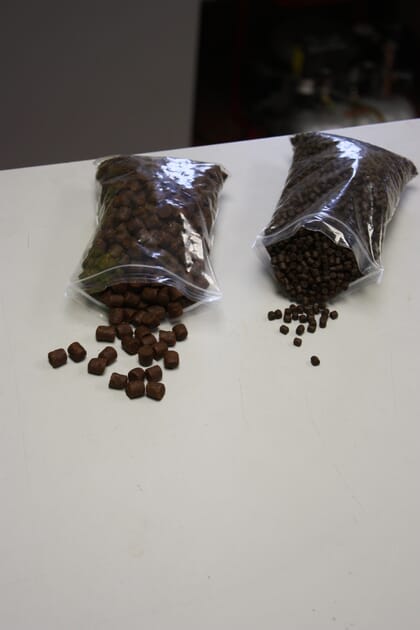
© Biomar
Most diet forms are sold as dry products with 10 percent moisture or less so that they do not have to be stored refrigerated or frozen. Some semi-moist diets (20 percent to 35 percent moisture) are available primarily for feeding early life stages of carnivorous species. These feeds must be refrigerated or frozen for long-term storage.
Manufacturing processes include grinding feedstuffs to reduce the particle size, mixing the feedstuffs, subjecting them to moisture (water and/or steam), and applying heat and pressure to produce a particular product form.
The most common types of manufacturing for aquatic feeds are compression pelleting, which makes sinking pellets, and cooking extrusion, which produces pellets that sink or float.
Pellet mills use steam to moisten and heat the feed mixture to approximately 160 to 185 °F and 15 percent to 18 percent moisture in a preconditioning chamber before passing it through a pellet die to produce a compressed pellet of the desired size.
Although some cooking of the ingredients and gelatinisation of starch occurs during the pre-conditioning and pelleting process, a pellet binder is typically included in the mixture to increase pellet durability.
Extrusion processing also uses a preconditioning chamber to subject the feed mixture to heat and moisture from steam, but it subjects the feed mixture to higher moisture (~25 percent) and much higher temperatures (190 to 300 °F) as it passes down the extruder barrel until it is forced out the end through a die.
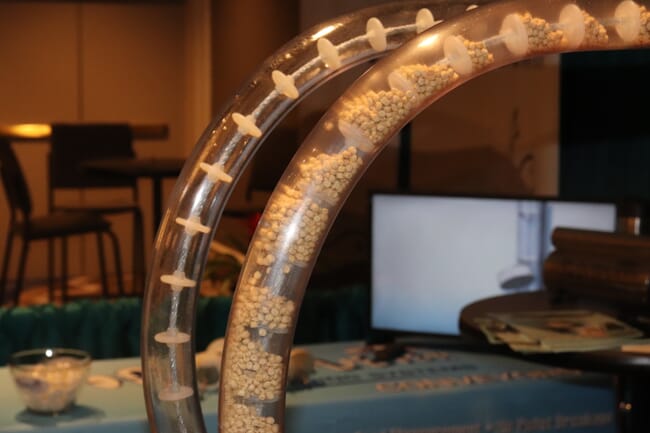
Considerable amounts of heat and pressure develop as the mixture passes along the extruder barrel. A rapid reduction in pressure when the mixture exits the die results in vaporisation of some moisture in the mixture so that the pellets expand, reducing their density. Extruded pellets must be dried in a dryer to reduce moisture levels to 8 to 10 percent so they can be stored without refrigeration.
There are limits to the amount of lipid that can be included in pellets because of frictional losses during processing. One of the advantages of the extrusion process over pelleting is that expanded pellets will absorb more lipid, which is applied with a fat coater.
Fat is usually applied after drying and just before the feed is directed to storage bins. The fat coating adds energy to the diet and may improve palatability and reduce feed dust. The finished feed is taken from storage bins to be either bagged or loaded into trucks for bulk delivery.
Diet forms for small fish can be produced by various methods. Microbinding, microcoating and microencapsulation procedures will produce larval feeds ranging in size from 25 to 400 microns (Hardy and Barrows, 2002).
Traditional meals and crumbles are produced by reducing the particle size of pellets and screening them into specific size ranges. The processing procedures and diet forms selected for feeding small fish of a given species may depend not only on the fish’s nutritional needs but also on matching the diet’s physical characteristics to those of the culture system for best distribution.
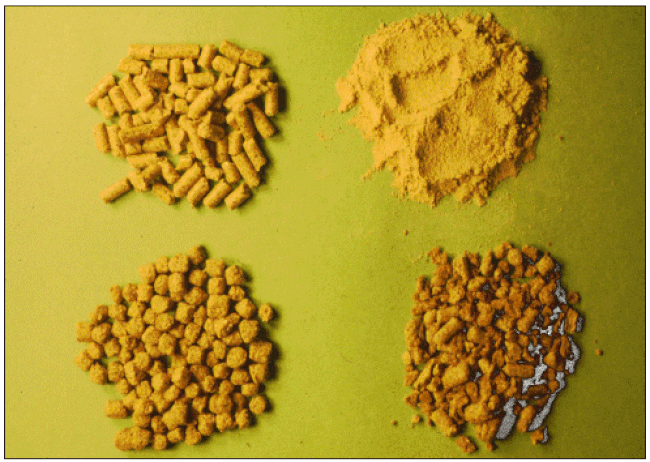
Feeding practices
Feeding practices affect production efficiency and the nutritional value of prepared feeds. When selecting a feeding practice, it is important to consider the life stage of the fish, the water temperature and its effect on fish metabolism, the physical characteristics of the culture system, and the availability of natural food items. There is no “standard” method for feeding fish. However, there are some general principles that should be followed whenever possible.
Natural foods
In certain culture systems (eg, ponds), the food that is naturally available can make a valuable contribution to the nutrition of some life stages of fish. Producers should promote the growth of natural food when possible, using prepared feeds as a supplement.
As fish grow older, they will need more nutrition than their environment can provide, especially under intensive production conditions, and should be given nutritionally complete prepared feeds. In culture systems such as raceways, cages/net pens and recirculating systems, where natural food is minimal, the use of nutritionally complete prepared feeds is critical.
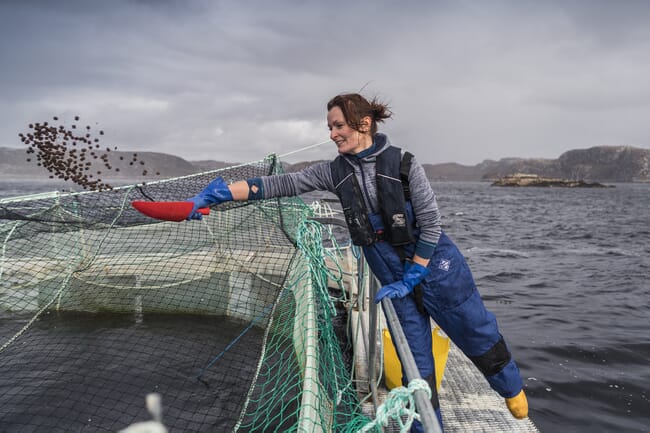
Feeding schedules based on water temperature and/or fish size
For a number of fish species that have been cultured for several decades, such as rainbow trout and channel catfish, various feeding schedules have been empirically developed that take into account the effects of water temperature and fish size on the relative feed intake of the fish expressed as a percentage of body weight.
Such schedules specify that prescribed amounts of feed be given at certain intervals. In general, the feeding frequency and feed quantity (expressed as a percent of body weight) are reduced as fish size increases and water temperature departs from optimum (Lovell, 2002). Feed manufacturers may provide such feeding schedules as general guides. They are also available in various publications (eg, Lovell, 2002; assorted SRAC publications on the production of individual fish species).
Feeding to apparent satiation
In certain culture systems, such as large ponds, it may be difficult to maintain an accurate estimate of fish biomass, in which case fish can be fed to “apparent satiation.” This feeding method can be rather subjective because it depends on the feeding activity of the fish and the experience of the feeder.
Ideally, feed should be provided in small amounts over the course of 20 to 30 minutes or until feeding activity slows. This approach gives all fish ample opportunity to obtain some feed, especially after the most aggressive fish have consumed all they want.
However, this method does require considerable amounts of time when multiple culture systems are being managed. Generally, it is better to underfeed than to feed too much because the uneaten feed will not only be wasted but also might degrade water quality. And if water quality is not good (especially dissolved oxygen levels and total ammonia nitrogen concentrations) it might not be possible to feed fish all they will consume.
Demand feeders can be used under certain circumstances. These allow fish to consume feed whenever they desire. A demand feeder has a feed storage container with a conical-shaped bottom and a disc located slightly below the conical bottom. A metal rod extends into the water. When fish touch the rod, feed is dropped into the water.
The quantity dispensed can be adjusted. This type of feeder is commonly used in the production of rainbow trout in raceways. Demand feeders should be checked regularly to make sure they are working properly and to refill with feed.
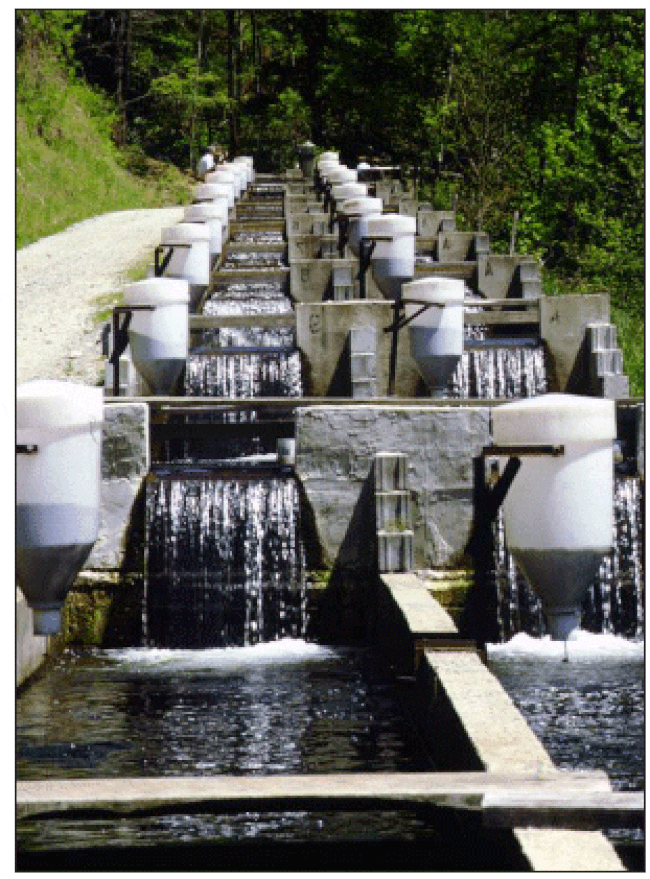
Feeding frequency and distribution
The frequency with which feed is distributed is primarily determined by fish size and the characteristics of the culture system. Young fish grow faster and have better feed efficiency when fed several times a day. Older fish do not exhibit the same benefits from frequent feeding.
Feeding can be done by hand or with automatic feeders. These feeders come in many different designs such as belt conveyers or vibrating dispensers, but generally can be adjusted to provide specific amounts of feed at set intervals.
In hatcheries and other small systems, fish are often fed several times a day. In larger culture systems such as ponds, this practice is more time consuming and the fish may not benefit as much because they have access to natural food.
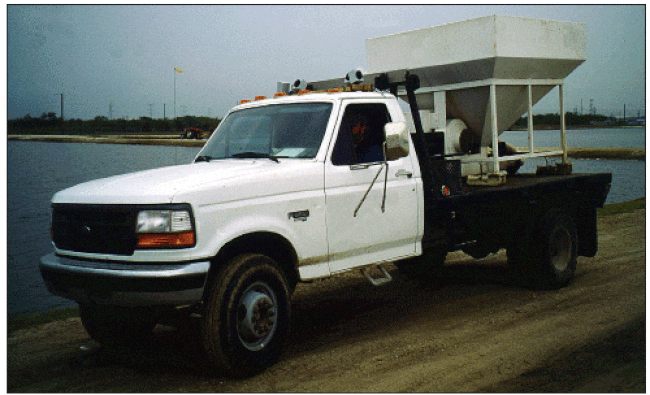
Adequate distribution of the feed is another important consideration. Feed is easy to distribute in relatively small culture systems such as raceways, cages, net pens or intensive flow-through or recirculating water systems.
Distributing feed in large ponds is more difficult. Feed blowers mounted on or pulled behind trucks are commonly used to dispense feed in ponds.
It is generally recommended that feed be distributed down one or more sides of the pond to make it accessible to as many fish as possible. If feeding must be limited to one levee, as on large facilities where numerous ponds must be fed daily, feed should be distributed from the upwind levee so it will disperse out into the pond.
Medicated feeds
One of the most effective ways of treating fish for bacterial infections, especially in large culture systems, is to use medicated feed. Three commercial antibiotic products— oxytetracycline, sulfadimethoxine/ormetoprim and florfenicol—have been approved by the US Food and Drug Administration (FDA) for use in the farming of fish destined for human consumption.
The quantity of antibiotic fed must be controlled. Proper feeding rates and withdrawal times must be followed to reduce the deposition of antibiotics into fish tissues or the release of antibiotics into the rearing water that may be discharged into the aquatic environment.
Specific administration and withdrawal procedures for the various antibiotics and targeted fish species were established during the registration process. Antibiotics may be added to feeds in the US only by a licensed manufacturer.
Conclusions
Reliable estimates of nutrient requirements have been established for major cultured fish species. These estimates are rather similar among species whose natural feeding habits and environmental requirements are comparable.
There is also information about the nutritional value and suitability of common feedstuffs used in fish feeds. This knowledge has guided the development of diet formulations and feed management practices that promote efficient and cost-effective production while maintaining the health of the cultured species.




